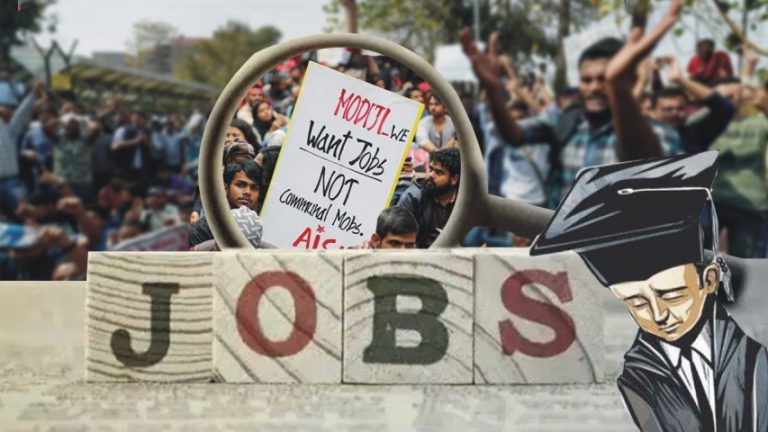

A source of earning is must to live a simple life and therefore people look for some employment in organized or un-organized government or private sectors for job opportunities.
To make this search more fruitful, young people always go for education to acquire diplomas degrees as minimum qualifications or other type of vocational/professional courses required as essential to get a job.
 It is desired to be associated with traditional livelihood options but with growing population such options are highly strained and people have to look for other options.
It is desired to be associated with traditional livelihood options but with growing population such options are highly strained and people have to look for other options.
Other options come from different sectors which create employment like industries, banks, software companies, public sector undertakings and different government sectors. With increasing mechanization and automatization in industries, road and building constructions have already reduced the job opportunities.
Recent COVID-19 pandemic lockdown has further worsened the rising unemployment all over the world. Unemployment just like COVID-19 infections, causalities and recoveries have become a number game, making use of data and graphs to hide the real situation.
 The job availability in the market for the aspiring youth is most important for a healthy social fabric because joblessness will create a situation with many unwanted consequences not only for the individual but for his family and the society a s a whole.
The job availability in the market for the aspiring youth is most important for a healthy social fabric because joblessness will create a situation with many unwanted consequences not only for the individual but for his family and the society a s a whole.
With efforts to stop the spread of the novel coronavirus – particularly the closure of nonessential businesses are having an unprecedented impact on the economy.
The COVID-19 pandemic, and the subsequent lockdown measures instituted, yielded an unprecedented spike in India’s unemployment rates, particularly during the months of April and May.
The Centre for Monitoring Indian Economy (CMIE) Pvt. Ltd calculates its overall unemployment rate by conducting a survey that includes more than 174,000 households over a four-month period.
According to data from the CMIE, India’s overall unemployment rate for the month of July stood at 7.43 per cent. Among its major states, there is still cause for concern in Bihar (12.19 per cent), Andhra Pradesh (8.35 per cent), Rajasthan (15.23 per cent), Telangana (9.05 per cent), and Delhi (20.3 per cent), all of which have recorded rates markedly higher than the national average.
 With all type of businesses activities being shuttered due to COVID-19 has caused a huge wave of reverse migration and the country’s overall joblessness rate rose as high as 27.11 for the week that ended by May 7, 2020.
With all type of businesses activities being shuttered due to COVID-19 has caused a huge wave of reverse migration and the country’s overall joblessness rate rose as high as 27.11 for the week that ended by May 7, 2020.
It will take time for the joblessness rate to return even to pre-COVID-19 levels. It is worth mentioning that India had been facing a crisis of employment or joblessness even prior to the pandemic times.
According to government figures, India’s unemployment rate for 2017-2018 fiscal year was pegged at 6.1 per cent, the highest in 45 years.
The massive layoffs and furloughs that have taken place since the start of March have highlighted the financial vulnerabilities of India’s heterogenous MSMEs that form the spine of the country’s economy.
 Contrary to what many believe, India’s MSMEs are spread widely across the country with 63 million or 50 per cent of such firms, contributing to 30 per cent of India’s GDP, located in rural areas.
Contrary to what many believe, India’s MSMEs are spread widely across the country with 63 million or 50 per cent of such firms, contributing to 30 per cent of India’s GDP, located in rural areas.
Positive thinkers are always optimistic that an economic recovery may be and largely driven by a revival in the agricultural segment but it is worth noting that, according to a Credit Suisse analysis dated July 20, 2020 agriculture accounts for just 29 per cent of the rural economy.
The rest of the rural economy consists of manufacturing, construction, public sector work, communication and financial services. Some of startling facts about joblessness from different media sources are summarized as:
• Of the 122 million who have lost their jobs, 91.3 million were small traders and labourers.
• A fairly significant number of salaried workers – 17.8 million – and self-employed people – 18.2 million – have also lost work during pandemic.
• Further, the unemployment rate in the country will rise to a shocking level of 32.5 per cent.
• Construction and farm sector workers account for the majority of job losses during lockdown.
• According to some reports, as many as 125 million households had applied for work under MGNREGA scheme between April and July, 2020 compared to 90 million households during the same period last year, with a phenomenal rise of nearly 40 per cent signifying the grave scenario of joblessness even in rural India.
• India will see 2.3 million youth losing jobs.
• As many as 6.1 million young people (15-24 years) may lose jobs in India in 2020 if the containment of the virus takes six months (roughly till September), says a report by Asian Development Bank (ADB) and International Labour Organization (ILO).
The personal and social costs of unemployment include severe financial hardship, poverty, debt, homelessness, housing stress, family tensions and breakdown, boredom, alienation, shame and stigma, increased social isolation, increased crime rates, increased stress levels, suicides, erosion of confidence and self-esteem.
 All these problems due to joblessness can lead an individual to depression, low self-esteem, anxiety, other mental health issues or suicide, especially if an individual truly wants a job but can’t find employment.
All these problems due to joblessness can lead an individual to depression, low self-esteem, anxiety, other mental health issues or suicide, especially if an individual truly wants a job but can’t find employment.
Individuals may become dispirited by unemployment and not only lose their self-esteem and confidence but also stop respect for education and society at large and further, the joblessness may affect their motivation to work.
Certainly, both the national economy, and society in general, suffer from high rates of unemployment especially when it becomes long-term. Unemployment situation also means loss of output and as the economy will be working below full potential and thus tax revenues will be lower and paying for more state benefits will further cost the economy. ![]()

Disclaimer : PunjabTodayTV.com and other platforms of the Punjab Today group strive to include views and opinions from across the entire spectrum, but by no means do we agree with everything we publish. Our efforts and editorial choices consistently underscore our authors’ right to the freedom of speech. However, it should be clear to all readers that individual authors are responsible for the information, ideas or opinions in their articles, and very often, these do not reflect the views of PunjabTodayTV.com or other platforms of the group. Punjab Today does not assume any responsibility or liability for the views of authors whose work appears here.
Punjab Today believes in serious, engaging, narrative journalism at a time when mainstream media houses seem to have given up on long-form writing and news television has blurred or altogether erased the lines between news and slapstick entertainment. We at Punjab Today believe that readers such as yourself appreciate cerebral journalism, and would like you to hold us against the best international industry standards. Brickbats are welcome even more than bouquets, though an occasional pat on the back is always encouraging. Good journalism can be a lifeline in these uncertain times worldwide. You can support us in myriad ways. To begin with, by spreading word about us and forwarding this reportage. Stay engaged.
— Team PT


Copyright © Punjab Today TV : All right Reserve 2016 - 2024 |